
1. Czech Republic and Poland. Some people were buried in mass graves, then disinterred and the remains put in Charnel houses for reasons including the overwhelm of epidemic, or war.
For Charnel Houses relating to Plague or the Thirty Years' War (early 1600's) see post for the walled church near Kutna Hora CZ, window view shown here, at Czech Republic Road Ways.
See also the post for Kudowa Zdroj at Poland Road Ways. More graphic. No filming was allowed inside; the view there is also
from the outside windows.
We did not visit the monastery at Sedlec, near Kutna Hora CZ where the bones were made into chandeliers and other decorative objects - sconces, etc. Not just lack of time, but also we liked our quiet times at these places and didn't want death with bling. See it here: www.discoverczech.com/multimedia-gallery/picture-detail.php4?obrazek=500600; or do a simple Images search for Sedlec. Forty thousand people in parts for your illumination.
2. Romania.
 Some graves are hauntingly colorful. Here is the Merry Cemetery in Romania, in Sapinta in the northwestern section near Ukraine.
Some graves are hauntingly colorful. Here is the Merry Cemetery in Romania, in Sapinta in the northwestern section near Ukraine.A woodcarver in the 1930's, I believe, began memorializing people's lives and how they died on their wooden markers. The tradition continues. One here shows, as affirmed by an English-speaking Romanian nearby, a man being shot by a firing squad, or patrol of Germans. See more at Romania Road Ways. Other carvings show butchers, housewives, bed-ridden people, smiling people, children with a car coming at them, stories all.
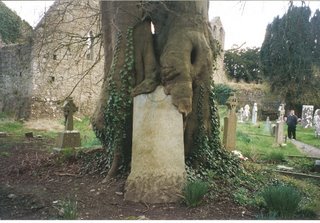
3. Ireland. Some graves are close to roots. This one is in Ireland, in the middle of someone's commercial opportunity, a monastery ruin in the middle of a golf course.
 4. France. An admirer still leaves flowers for WWII singer Edith Piaf at Pere Lachaise cemetery in Paris.
4. France. An admirer still leaves flowers for WWII singer Edith Piaf at Pere Lachaise cemetery in Paris. More France: Here, at the Ossuary at Verdun, from the campaign 1916-1917, are the various remains of some 150,000 unknown soldiers, German and French, Moroccan, Foreign Legion. They are beneath a central spiral in this large memorial, names lining the bays. See World War. This is an original old postcard of ours, a very small collection from Verdun, no date (unused) but very yellowed, with French captioning.
More France: Here, at the Ossuary at Verdun, from the campaign 1916-1917, are the various remains of some 150,000 unknown soldiers, German and French, Moroccan, Foreign Legion. They are beneath a central spiral in this large memorial, names lining the bays. See World War. This is an original old postcard of ours, a very small collection from Verdun, no date (unused) but very yellowed, with French captioning.
5. Croatia. And here, a photograph shows us just who this individual 16-year old Terezija was, in Croatia, and she is ever reading.

6. Bosnia. In some places, graves are cast off.
Here, a graveyard and a road runs through it. Graveyard, Bogomils, old Christian sect 9th-12th Centuries, killed off by the self-proclaimed true church, Bosnia. See history at www.nationsencyclopedia.com/Europe/Bosnia-and-Herzegovina-HISTORY. Start wiath the home page at the dot com, then move to the specifics if you can.
7. Ireland. Some graves witness specific tragic eras. Famine cemetery, Skibbereen, Ireland.

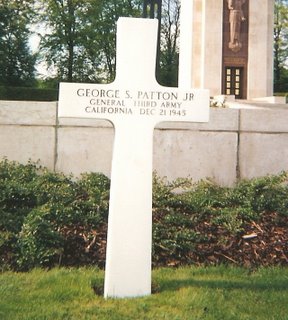

8. Luxembourg. Some graves seem like an anticlimax, given the publicity given to the person elsewhere.
The great WWII General Patton is buried off in Luxembourg, but is better known for his campaigns elsewhere. He is at the US Military Cemetery at Hamm, Luxembourg. He lies facing his 7-8,000 troops, though. We got here just in time to help with the flag. so far away. Not many Americans do come here, I understand. Excellent. Attention should be paid.
8. The Netherlands. Some graves are remembered with vast speeches and memorial days. Here, festive remembrance. VE Day parade, Nijmegen, The Netherlands. The "A Bridge Too Far" bridge is just north, at Arnhem. Nijmegen's bridge is where Americans fought, I understand, as part of Operation Market Garden.

9. Germany. Some graves are mass graves, preserving where huge numbers of people perished.

See Buchenwald Concentration Camp, near Weimar, Germany. See the stones for remembrance, and other cultural-practical roots, at this ground headstone at Buchnwald, Germany. Nearby is the little bear pit, a dear child size zoo thing, where the Nazi's children and families, and any assigned "help," would sit and play and watch the bears while the inmates were just beyond, behind the barbed wire fence over there.
10. France. Here, battlefield at Vimy Ridge, France. Trenches, craters and hills showing where uprooted trees fell, or blasts. WWI. Area cannot be easily mowed, so sheep safely graze there. There are often large ossuaries at WWI grave areas. Fragments so small.

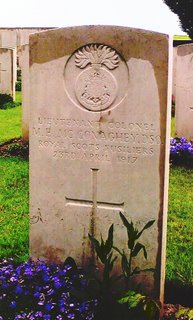
11. Arras, France. Some graves are pocket-size, especially from WWI, where you can find a family member. Here is our grave of relative Lt. Col. Maurice McConaghey, Royal Scots Fusiliers 1917, WWI, Arras, France. See post in WWI Finding Graves.
12. Belgium. Some graves have huge monuments.
Remembering with monuments. Canadian Memorial, Ypres, Belgium, WWI. Uncle Len was there. He was in the Canadian forces, gassed, but survived.


13. Belgium. And the American Memorial, Bastogne, Belgium (WWII). Such admiration and gratitude for the
American soldiers' efforts and heroism here. This - the idea that you are doing good after all - is a legacy that our leaders today are taking from our soldiers, I think.
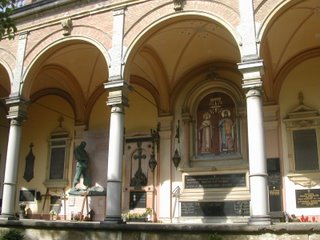 14. Croatia. Some graves are in large grand mausoleums. See the formal cemeteries at Miragoj Cemetery, Zagreb, Croatia: Orthodox Christians, Roman Catholics, and carefully alphabetized and birth-death dates and names of German soldiers, WWII.
14. Croatia. Some graves are in large grand mausoleums. See the formal cemeteries at Miragoj Cemetery, Zagreb, Croatia: Orthodox Christians, Roman Catholics, and carefully alphabetized and birth-death dates and names of German soldiers, WWII.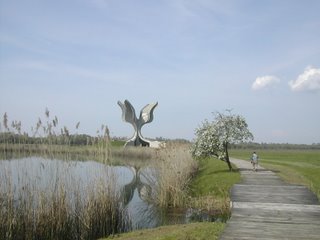
15. Croatia. Some graves are virtually forgotten. Here is Jasenovac Concentration Camp site, 1940's, Croatia: The dead here are not only Nazi-targeted groups, but Orthodox Christians, numbers vary 60,000-600,000. Belongings and photos now at Holocaust Museum, Washington, DC. Everything closed up, broken here. Where do families go to find their people?
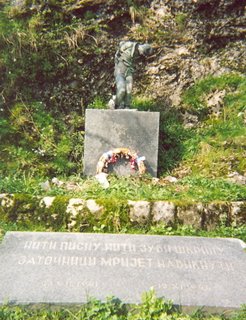 16. Montenegro. Some graves become rallying points. Here, a firing squad memorial in Montenegro (Cetinje).
16. Montenegro. Some graves become rallying points. Here, a firing squad memorial in Montenegro (Cetinje).17. To find graves, try Geneology sites: www.myheritageresearch.com/. This one uses over 400 sources, including world cemetery regords; and www.familysearch.org/; good for using American and Canadian census materials, death indexes and some marriage and birth records; and www.ancestry.com/. This one includes military records, court, land and some probate records for US, and some UK census. And www.legacy.com/. This has some 5 million recent and old obituaries, daily newspapers, past 6 years only, I think. Check. These overviews are from the Wall Street Journal of June 22, 2006.
18. United States. Some reflect the personality of the person beneath. See an all-American attitude veteran's grave, at Saratoga, NY:

...................................................................................
Cemeteries are for the living, says Jay Walljasper in his book, "The Great Neighborhood Book," New Society Publishers 2007. See him at www.pps.org/info/aboutpps/staff/jwalljasper. Return to them as parks, attractions, for picnics.
There is also a cemetery preservationist at the Connecticut Gravestone Network, Ruth Shapleigh-Brown, see www.ctgravestones.com/Contact_info. who helps with the finding.
Resources:
1. Site for finding overviews of whatever country your people may have come from: www.everyculture.com/multi/index. Overview, Country and Culture.
2. Site for finding graves of famous, infamous and not famous people: www.findagrave.com/index.

